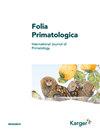Species Boundaries within Morphologically Cryptic Galagos: Evidence from Acoustic and Genetic Data
IF 1.2
4区 生物学
Q2 ZOOLOGY
引用次数: 8
Abstract
Describing primate biodiversity is one of the main goals in primatology. Species are the fundamental unit of study in phylogeny, behaviour, ecology and conservation. Identifying species boundaries is particularly challenging for nocturnal taxa where only subtle morphological variation is present. Traditionally, vocal signals have been used to identify species within nocturnal primates: species-specific signals often play a critical role in mate recognition, and they can restrict gene flow with other species. However, little research has been conducted to test whether different “acoustic forms” also represent genetically distinct species. Here, we investigate species boundaries between two putative highly cryptic species of Eastern dwarf galagos (Paragalago cocosand P. zanzibaricus). We combined vocal and genetic data: molecular data included the complete mitochondrial cytochrome b gene (1,140 bp) for 50 samples across 11 localities in Kenya and Tanzania, while vocal data comprised 221 vocalisations recorded across 8 localities. Acoustic analyses showed a high level of correct assignation to the putative species (approx. 90%), while genetic analyses identified two separate clades at the mitochondrial level. We conclude that P. cocos and P. zanzibaricus represent two valid cryptic species that probably underwent speciation in the Late Pliocene while fragmented in isolated populations in the eastern forests.形态隐加拉戈斯群岛的物种边界:来自声学和遗传数据的证据
描述灵长类动物的生物多样性是灵长类动物学的主要目标之一。物种是研究系统发育、行为、生态学和保护的基本单位。识别物种边界是特别具有挑战性的夜间类群,只有细微的形态变化存在。传统上,声音信号被用来识别夜行灵长类动物的物种:物种特异性信号通常在配偶识别中起着关键作用,它们可以限制与其他物种的基因流动。然而,很少有研究来测试不同的“声音形式”是否也代表遗传上不同的物种。在这里,我们调查了两个假定的高度隐蔽的东方矮加拉戈斯物种(Paragalago cocoand P. zanzibaricus)之间的物种边界。我们将声音和遗传数据结合起来:分子数据包括肯尼亚和坦桑尼亚11个地区50个样本的完整线粒体细胞色素b基因(1,140 bp),而声音数据包括8个地区记录的221次发声。声学分析显示了对假定物种的高度正确的分配(大约。90%),而基因分析在线粒体水平上发现了两个独立的分支。我们认为,P. cocos和P. zanzibaricus代表了两个有效的隐种,它们可能在上新世晚期经历了物种形成,而在东部森林的孤立种群中分散。
本文章由计算机程序翻译,如有差异,请以英文原文为准。
求助全文
约1分钟内获得全文
求助全文
来源期刊

Folia Primatologica
生物-动物学
CiteScore
3.30
自引率
10.50%
发文量
36
审稿时长
>12 weeks
期刊介绍:
Recognizing that research in human biology must be founded on a comparative knowledge of our closest relatives, this journal is the natural scientist''s ideal means of access to the best of current primate research. ''Folia Primatologica'' covers fields as diverse as molecular biology and social behaviour, and features articles on ecology, conservation, palaeontology, systematics and functional anatomy. In-depth articles and invited reviews are contributed by the world’s leading primatologists. In addition, special issues provide rapid peer-reviewed publication of conference proceedings. ''Folia Primatologica'' is one of the top-rated primatology publications and is acknowledged worldwide as a high-impact core journal for primatologists, zoologists and anthropologists.
 求助内容:
求助内容: 应助结果提醒方式:
应助结果提醒方式:


